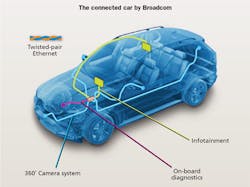The broadening structure of copper cabling systems
By Harshang Pandya, InspiRain Technologies Pte Ltd.
Back in 2002 I had my first exposure to the cabling world as a research-and-development engineer. My first task was to make sure that a field tester I was working on removed the effects of the patch-cord connector on the tester side for channel measurements. I still remember how strange I felt about that assignment. That connector, I knew, was going to play a role in how well the data flowed in the cable. But it was supposed to be “untested.” Even though the tester already tested that connector, I was going to be paid to make it not tested. I am very happy about the recent developments toward defining “plug-terminated links,” and “end-to-end links.” We are broadening the structure of the cabling, in fact in more ways than most of us would imagine. The new “structure” is expanding the scope of deployment of copper cabling well beyond just office buildings and campuses.
Copper cables can carry both data and power. This single advantage, reflected in Power over Ethernet (PoE) systems, will make copper cables compelling for years to come. And copper is easy to handle. I have successfully terminated a few cables myself. My record with handling fiber-optic cable is far from enviable. I once had a newly developed fiber-adapter prototype of a cable tester, where the referencing was not making sense. Our quality-assurance guy thought it was a bug in the software I wrote. After reviewing patiently, my code looked alright—not just to me, but even to other, smarter colleagues. So I suspected the cable that was used for referencing. I tried all the other fiber cables in our lab, and the result still would not make sense. I was horrified later to find that this whole issue was caused by some dust settling on the endface of the connector on the tester’s fiber adapter. What I inadvertently did was damage endfaces of all the sample fiber cables in my lab by rubbing them against the bad connector on the test adapter. Copper cables and connectors are more forgiving to poorly skilled technicians like me. And I am convinced there are many such technicians out there. And is copper still cheaper? I am not following the prices, but I believe that is still the case. By the way, Category 8 is another sign that copper cables are here to stay. I follow the announcements of test instruments; that is my world. There is a “first” Category 8 tester, and there is a “true” Category 8 tester. That shows someone still senses opportunities in Category 8 cabling.
Back to the topic of structure. Ten years back, would you have imagined the Telecommunications Industry Association (TIA) standardizing a connector other than RJ45? They just did that with Category 8.2 specifications. A channel was supposed to be specified to 100 meters—not a meter less. That changed with Category 8. The reason? The changing “structure” of the structured cabling. Data centers have a large number of short-distance links that carry enormous amounts of data. And these links in most cases don’t need to go to wall outlets; they just need to provide end-to-end connections between the server and the switch.
We are used to, and comfortable with, a typical commercial office building as the site at which we install cabling. But what would you think about installing cables at a “site” that is actually the interior of an automobile?
This is what I mean by changing “structure.” So many aspects of the structured cabling systems assumed where and how the cable was going to be used. There was, perhaps unwritten, an assumption that every cubicle in every office would have a person working at a computer, with a patch cord connecting it to a wall outlet, and then to the hidden permanent link connecting that cable to the telecom room and some patch panel. How do we adapt to the new scenario? Hardly any computing devices now have cable connections. The main function of cables in enterprises now is to connect wireless access points, as well as the security cameras and the distributed antenna system (DAS) antennas. Most of these devices need to be powered, and this is best done by PoE-enabled copper links.
What has survived this significant structural change is the combination of Ethernet and twisted-pair cables. Everything else seems to be shaking up the structure. The site does not need to be a fixed concrete structure. It can be a vehicle. The cables no longer have to have four pairs. New automotive and industrial Ethernet cables will have just one pair. Computers might not need Ethernet cables anymore, but now TV sets want them (for HDBase-T), and LED lights—along with a lot of other IoT devices—now want Ethernet cables too.
I like to use the term “adaptive copper cabling systems” to characterize the application environments in which twisted-pair cables are now deployed. A few months ago, during an IEC standards meeting in my home city-state of Singapore, almost all the cabling professionals I talked to told me they sold more copper cables in 2016 than in previous years. But they had to adapt to the changing “structure” of these systems.
The test-instrument engineer in me asks: What does it mean for testers? Do we look beyond channel adapters and permanent link adapters? How about testing different numbers of pairs, different bundling schemes, and different “sites”? I don’t claim to know all the answers, but it sure is going to be fun finding out. u
Harshang Pandya is principal of InspiRain Technologies Pte Ltd. (www.inspirain-tech.com).


